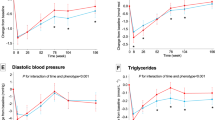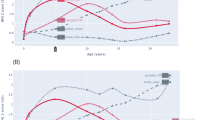Abstract
Objective:
This study aims to assess the natural course of metabolically healthy abdominal obese (MHAO) phenotype and determine the predictors of change in the metabolic status in this population over 10 years of follow-up.
Methods:
A total of 916 MHAO subjects from the Tehran Lipid and Glucose Study were followed for changes in their metabolic health status. Anthropometric and metabolic indices were measured at baseline and were compared between subjects with healthy and unhealthy metabolic conditions at the end of follow-up. Predictors of change in metabolic health were assessed in logistic regression models. National waist circumference cutoffs were used for definition of abdominal obesity. Metabolic health was defined as ⩽1 metabolic components of metabolic syndrome according to the Joint Interim Statement criteria.
Results:
At the end of the follow-up, nearly half of the MHAO subjects lost their metabolic health and 42.1% developed metabolic syndrome by definition. Low high-density lipoprotein cholesterol, hypertriglyceridemia and homeostasis model assessment-insulin resistance at baseline were significant predictors of change in metabolic health condition.
Conclusion:
MHAO is a relatively unstable condition and a considerable percentage of these individuals will lose their metabolic health as time passes. Baseline metabolic characteristics may be useful predictors of this change and should be considered in the care of these individuals.
This is a preview of subscription content, access via your institution
Access options
Subscribe to this journal
Receive 12 print issues and online access
$259.00 per year
only $21.58 per issue
Buy this article
- Purchase on Springer Link
- Instant access to full article PDF
Prices may be subject to local taxes which are calculated during checkout
Similar content being viewed by others
References
World Health Organization. Global health risks: mortality and burden of disease attributable to selected major risks. World Health Organization: Geneva, 2009.
Guh DP, Zhang W, Bansback N, Amarsi Z, Birmingham CL, Anis AH . The incidence of co-morbidities related to obesity and overweight: a systematic review and meta-analysis. BMC Public Health 2009; 9: 88.
Ruderman NB, Schneider SH, Berchtold P . The ‘metabolically-obese,’ normal-weight individual. Am J Clin Nutr 1981; 34: 1617–1621.
Sims EA . Are there persons who are obese, but metabolically healthy? Metabolism 2001; 50: 1499–1504.
Karelis AD, Brochu M, Rabasa-Lhoret R . Can we identify metabolically healthy but obese individuals (MHO)? Diabetes Metab 2004; 30: 569–572.
Meigs JB, Wilson PW, Fox CS, Vasan RS, Nathan DM, Sullivan LM et al. Body mass index, metabolic syndrome, and risk of type 2 diabetes or cardiovascular disease. J Clin Endocrinol Metab 2006; 91: 2906–2912.
Hamer M, Stamatakis E . Metabolically healthy obesity and risk of all-cause and cardiovascular disease mortality. J Clin Endocrinol Metab 2012; 97: 2482–2488.
Kramer CK, Zinman B, Retnakaran R . Are metabolically healthy overweight and obesity benign conditions?: a systematic review and meta-analysis. Ann Intern Med 2013; 159: 758–769.
Aung K, Lorenzo C, Hinojosa MA, Haffner SM . Risk of developing diabetes and cardiovascular disease in metabolically unhealthy normal-weight and metabolically healthy obese individuals. J Clin Endocrinol Metab 2013; 99: 462–468.
Bluher M . Are there still healthy obese patients? Curr Opin Endocrinol Diabetes Obes 2012; 19: 341–346.
Despres JP . Health consequences of visceral obesity. Ann Med 2001; 33: 534–541.
Brenner DR, Tepylo K, Eny KM, Cahill LE, El-Sohemy A . Comparison of body mass index and waist circumference as predictors of cardiometabolic health in a population of young Canadian adults. Diabetol Metab Syndr 2010; 2: 28.
Janiszewski PM, Janssen I, Ross R . Does waist circumference predict diabetes and cardiovascular disease beyond commonly evaluated cardiometabolic risk factors? Diabetes Care 2007; 30: 3105–3109.
van der AD, Nooyens AC, van Duijnhoven FJ, Verschuren WM, Boer JM . All-cause mortality risk of metabolically healthy abdominal obese individuals: The EPIC-MORGEN study. Obesity (Silver Spring) 2013; 22: 557–564.
Appleton SL, Seaborn CJ, Visvanathan R, Hill CL, Gill TK, Taylor AW et al. Diabetes and cardiovascular disease outcomes in the metabolically healthy obese phenotype: a cohort study. Diabetes Care 2013; 36: 2388–2394.
Soriguer F, Gutierrez-Repiso C, Rubio-Martin E, Garcia-Fuentes E, Almaraz MC, Colomo N et al. Metabolically healthy but obese, a matter of time? Findings from the prospective Pizarra study. J Clin Endocrinol Metab 2013; 98: 2318–2325.
Hosseinpanah F, Nazeri P, Ghareh S, Tohidi M, Azizi F . Predictors of the incident metabolic syndrome in healthy obese subjects: a decade of follow-up from the Tehran Lipid and Glucose Study. Eur J Clin Nutr 2013; 68: 295–299.
Cheung BM, Wat NM, Tam S, Thomas GN, Leung GM, Cheng CH et al. Components of the metabolic syndrome predictive of its development: a 6-year longitudinal study in Hong Kong Chinese. Clin Endocrinol 2008; 68: 730–737.
Heidari Z, Hosseinpanah F, Mehrabi Y, Safarkhani M, Azizi F . Predictive power of the components of metabolic syndrome in its development: a 6.5-year follow-up in the Tehran Lipid and Glucose Study (TLGS). Eur J Clin Nutr 2010; 64: 1207–1214.
Azizi F, Rahmani M, Emami H, Madjid M . Tehran lipid and glucose study: rationale and design. CVD Prevention 2000; 3: 242–247.
Ainsworth BE, Jacobs Jr DR, Leon AS . Validity and reliability of self-reported physical activity status: the Lipid Research Clinics questionnaire. Med Sci Sports Exerc 1993; 25: 92–98.
Azizi F, Ghanbarian A, Momenan AA, Hadaegh F, Mirmiran P, Hedayati M et al. Prevention of non-communicable disease in a population in nutrition transition: Tehran Lipid and Glucose Study phase II. Trials 2009; 10: 5.
Alberti KG, Eckel RH, Grundy SM, Zimmet PZ, Cleeman JI, Donato KA et al. Harmonizing the metabolic syndrome: a joint interim statement of the International Diabetes Federation Task Force on Epidemiology and Prevention; National Heart, Lung, and Blood Institute; American Heart Association; World Heart Federation; International Atherosclerosis Society; and International Association for the Study of Obesity. Circulation 2009; 120: 1640–1645.
Delavari A, Forouzanfar MH, Alikhani S, Sharifian A, Kelishadi R . First nationwide study of the prevalence of the metabolic syndrome and optimal cutoff points of waist circumference in the Middle East: the national survey of risk factors for noncommunicable diseases of Iran. Diabetes Care 2009; 32: 1092–1097.
Hosseinpanah F, Borzooei S, Barzin M, Farshadi M, Sarvghadi F, Azizi F . Diagnostic values of metabolic syndrome definitions for detection of insulin resistance: Tehran Lipid and Glucose Study (TLGS). Arch Iran Med 2012; 15: 606–610.
Carmienke S, Freitag MH, Pischon T, Schlattmann P, Fankhaenel T, Goebel H et al. General and abdominal obesity parameters and their combination in relation to mortality: a systematic review and meta-regression analysis. Eur J Clin Nutr 2013; 67: 573–585.
Whitlock G, Lewington S, Sherliker P, Clarke R, Emberson J, Halsey J et al. Body-mass index and cause-specific mortality in 900 000 adults: collaborative analyses of 57 prospective studies. Lancet 2009; 373: 1083–1096.
Wormser D, Kaptoge S, Di Angelantonio E, Wood AM, Pennells L, Thompson A et al. Separate and combined associations of body-mass index and abdominal adiposity with cardiovascular disease: collaborative analysis of 58 prospective studies. Lancet 2011; 377: 1085–1095.
Matsuzawa Y, Funahashi T, Nakamura T . The concept of metabolic syndrome: contribution of visceral fat accumulation and its molecular mechanism. J Atheroscler Thromb 2011; 18: 629–639.
de Koning L, Merchant AT, Pogue J, Anand SS . Waist circumference and waist-to-hip ratio as predictors of cardiovascular events: meta-regression analysis of prospective studies. Eur Heart J 2007; 28: 850–856.
Janssen I, Katzmarzyk PT, Ross R . Waist circumference and not body mass index explains obesity-related health risk. Am J Clin Nutr 2004; 79: 379–384.
van Dijk SB, Takken T, Prinsen EC, Wittink H . Different anthropometric adiposity measures and their association with cardiovascular disease risk factors: a meta-analysis. Neth Heart J 2012; 20: 208–218.
Stefan N, Kantartzis K, Machann J, Schick F, Thamer C, Rittig K et al. Identification and characterization of metabolically benign obesity in humans. Arch Int Med 2008; 168: 1609–1616.
Voulgari C, Tentolouris N, Dilaveris P, Tousoulis D, Katsilambros N, Stefanadis C . Increased heart failure risk in normal-weight people with metabolic syndrome compared with metabolically healthy obese individuals. J Am Coll Cardiol 2011; 58: 1343–1350.
Ortega FB, Lee DC, Katzmarzyk PT, Ruiz JR, Sui X, Church TS et al. The intriguing metabolically healthy but obese phenotype: cardiovascular prognosis and role of fitness. Eur Heart J 2013; 34: 389–397.
Arnlov J, Ingelsson E, Sundstrom J, Lind L . Impact of body mass index and the metabolic syndrome on the risk of cardiovascular disease and death in middle-aged men. Circulation 2010; 121: 230–236.
den Engelsen C, Gorter KJ, Salome PL, Rutten GE . Development of metabolic syndrome components in adults with a healthy obese phenotype: a 3-year follow-up. Obesity (Silver Spring) 2013; 21: 1025–1030.
Achilike I, Hazuda HP, Fowler SP, Aung K, Lorenzo C . Predicting the development of the metabolically healthy obese phenotype. Int J Obes (Lond) 2014.
Karelis AD, Faraj M, Bastard JP, St-Pierre DH, Brochu M, Prud'homme D et al. The metabolically healthy but obese individual presents a favorable inflammation profile. J Clin Endocrinol Metab 2005; 90: 4145–4150.
Phillips CM, Perry IJ . Does inflammation determine metabolic health status in obese and nonobese adults? J Clin Endocrinol Metab 2013; 98: E1610–E1619.
Wildman RP, Kaplan R, Manson JE, Rajkovic A, Connelly SA, Mackey RH et al. Body size phenotypes and inflammation in the Women's Health Initiative Observational Study. Obesity (Silver Spring) 2011; 19: 1482–1491.
Hwang LC, Bai CH, You SL, Sun CA, Chen CJ . Description and prediction of the development of metabolic syndrome: a longitudinal analysis using a markov model approach. PLoS One 2013; 8: e67436.
Pataky Z, Makoundou V, Nilsson P, Gabriel RS, Lalic K, Muscelli E et al. Metabolic normality in overweight and obese subjects. Which parameters? Which risks? Int J Obes (Lond) 2011; 35: 1208–1215.
Eckel RH, Alberti KG, Grundy SM, Zimmet PZ . The metabolic syndrome. Lancet 2010; 375: 181–183.
Acknowledgements
We would like to thank Ms Niloofar Shiva for critical editing of English grammar and syntax of the manuscript, and also the staff and participants in the TLGS for their important contribution.
Author information
Authors and Affiliations
Corresponding author
Ethics declarations
Competing interests
The authors declare no conflict of interest.
Rights and permissions
About this article
Cite this article
Eshtiaghi, R., Keihani, S., Hosseinpanah, F. et al. Natural course of metabolically healthy abdominal obese adults after 10 years of follow-up: the Tehran Lipid and Glucose Study. Int J Obes 39, 514–519 (2015). https://doi.org/10.1038/ijo.2014.176
Received:
Revised:
Accepted:
Published:
Issue Date:
DOI: https://doi.org/10.1038/ijo.2014.176
This article is cited by
-
Gut microbiome signature of metabolically healthy obese individuals according to anthropometric, metabolic and inflammatory parameters
Scientific Reports (2024)
-
Abdominal obesity phenotypes are associated with the risk of developing non-alcoholic fatty liver disease: insights from the general population
BMC Gastroenterology (2022)
-
Association of Lifelines Diet Score (LLDS) and metabolically unhealthy overweight/obesity phenotypes in women: a cross-sectional study
BMC Women's Health (2022)
-
Wrist circumference as a novel predictor of transition from metabolically healthy to unhealthy phenotype in overweight/obese adults: a gender-stratified 15.5-year follow-up
BMC Public Health (2021)
-
Natural course of metabolically healthy phenotype and risk of developing Cardiometabolic diseases: a three years follow-up study
BMC Endocrine Disorders (2021)



